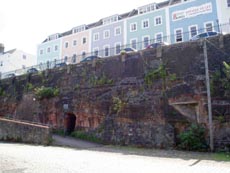|
|
 Bristol AreaWildlife
- There are over 300 plants, 18 butterflies and 70 species of birds in Bristol's Harbour and New Cut.
- Herring gulls (right), black-headed and black-backed gulls are regular visitors.
- Look out for peregrine falcons around the Cumberland Basin - they fly in from the Gorge to swoop on pigeons.
 Cormorants (below right) are now a common sight in Bristol Harbour. Cormorants (below right) are now a common sight in Bristol Harbour.- Further east, at Troopers Hill you can see acid heathland plants such as gorse and heather. Rare mining bees build their burrows
 in the bare slopes of the hill that have been eroded by past industrial activity. in the bare slopes of the hill that have been eroded by past industrial activity.
Geology
Upstream from the Gorge, the landscape changes as flat lying softer rocks (Triassic age) have been eroded by the river to form the wider Bristol valley. One slightly harder sandstone forms the hill at Redcliffe and another where Bristol Castle once stood. Under these rocks are the Coal Measures which were mined in Bedminster and Ashton. These contain the fossil remains of a tropical rain forest which flourished about 300 million years ago (Carboniferous age).
 The Triassic rocks that are most likely to be seen on this Trail are the Dolomitic Conglomerate and Redcliffe Sandstone. The Triassic rocks that are most likely to be seen on this Trail are the Dolomitic Conglomerate and Redcliffe Sandstone.
Fine-grained Triassic sandstone was quarried underground in the centre of Bristol, leaving Redcliffe Caves and the red cliff of the name; it is also to be seen in cuttings all along the New Cut of the River Avon from the Plimsoll Bridge up to Temple Meads Station. Find out more about the Avon New Cut Local Nature Reserve through its dedicated volunteer group FrANC.
The sandstone can be seen at several places along the Trail. It is thought that the sandstone was mined in the man-made Redcliffe Caves as a source of sand for making Bristol Glass nearby. The extensive cave system is accessed from beneath the houses in the picture. These caves were later used as a warehouse to store ships' cargoes.
|
|


